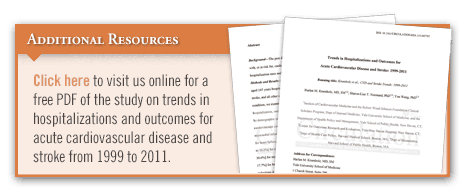Over the last decade, physicians and professional organizations have focused their efforts on improving the quality of care for cardiovascular disease (CVD) and stroke to ensure that proven interventions are appropriately administered. Groups such as the American College of Cardiology (ACC), American Heart Association (AHA), Society for Cardiovascular Angiography and Interventions (SCAI), and American Stroke Association (ASA) have supported efforts to measure performance and monitor care for CVD and stroke through registries and national quality improvement campaigns. In addition, CMS has initiated efforts to improve care and publicly report 30-day mortality and readmission rates for myocardial infarction (MI) and heart failure (HF).
Several reports suggest that hospitalization rates and outcomes for CVD and stroke have improved recently, but many of these analyses have focused on specific communities, populations, or conditions and did not assess the conditions together or look at demographic or geographic differences. “We need to consistently look at temporal trends in CVD and stroke outcomes over the long term to see where our efforts are working and to identify areas for improvement,” says Chandan M. Devireddy, MD.
New Long-Term Data
In a study published in Circulation, researchers analyzed a national cohort of all Medicare fee-for-service beneficiaries from 1999 to 2011 to evaluate trends in various CVD and stroke outcomes. The analysis explored rates of hospitalization, mortality, and readmission as well as payments, length of stay, and discharge disposition for unstable angina, MI, HF, and ischemic stroke. The study also assessed rates of hospitalization for all other conditions as a comparison and examined variations in demographic and geographic subgroups over time.
 “The strength of this research is robust data that use information from about 34 million claims over the course of about a decade,” explains Dr. Devireddy, who was not a study author but is familiar with the research findings. He notes that the Circulation study is one of the most comprehensive looks at the progress that has been made to date in preventing and treating CVD and stroke in the United States.
“The strength of this research is robust data that use information from about 34 million claims over the course of about a decade,” explains Dr. Devireddy, who was not a study author but is familiar with the research findings. He notes that the Circulation study is one of the most comprehensive looks at the progress that has been made to date in preventing and treating CVD and stroke in the United States.
Many Improvements
According to the results, efforts over the past decade to improve quality of care for CVD and stroke and increase use of evidence-based treatments have led to a significant drop in disease-attributable hospitalization and mortality rates. From 1999 to 2011, hospitalization rates declined for unstable angina, MI, HF, and ischemic stroke when compared with all other conditions (Figure). For example, hospitalization rates dropped by 38% for CVD patients overall and by nearly 84% among patients with unstable angina.
The researchers observed reductions in 30-day and 1-year mortality rates for unstable angina, MI, HF, and ischemic stroke. They also noted declines in 30-day readmission rates for each of these conditions (Table). Notably, the mortality rate within 1 year of hospitalization dropped by 21% for patients with unstable angina and decreased by 23% for those with MI.
The findings of the study are welcome news and support the notion that efforts to deliver timely and high-quality care to patients are valuable. “This report shows that we’re continuing to make significant progress in improving CVD and stroke outcomes, in large part because of recently expanded quality improvement initiatives from groups like the AHA, ACC, SCAI, and ASA,” Dr. Devireddy says. “These findings also occurred at a time during which few breakthrough therapies or treatments emerged.”
Continuous Commitment
Although the results are positive, Dr. Devireddy cautions that they also underscore the need to stay committed to these initiatives to continue improving outcomes and access to care. “The absolute number of cardiovascular events is still high, meaning there are still opportunities for improvement,” he says. “The goal is to continue improving these rates until we reach a point where we can remove CVD and stroke from the list of leading causes of death and disability. To reach this goal, we need to continue collaborating with professional associations and other clinicians to ensure that quality-driven initiatives are implemented throughout the country.”
Quality improvement efforts have been central to groups like the ACC, AHA, SCAI, and ASA, and each of these organizations has developed tools and programs to enhance quality of care. “These efforts are proving to help save lives, shorten hospital stays, and, in many cases, reduce readmission rates,” says Dr. Devireddy. “Our efforts must be measured against what is actually being accomplished for patients. The challenges ahead include further research efforts to better understand how cardiovascular events can be decreased, continued refinements in treatment approaches, and maintaining these positive trends.”



 TimH
TimH